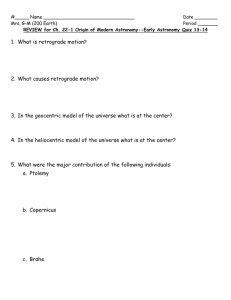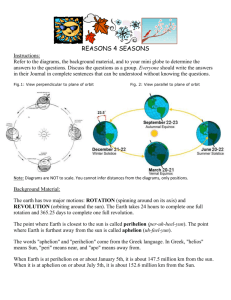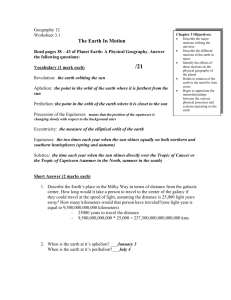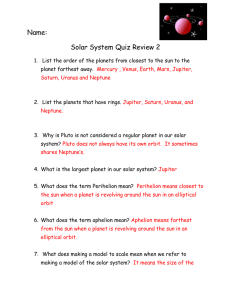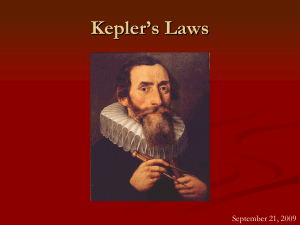Travel into Space
advertisement
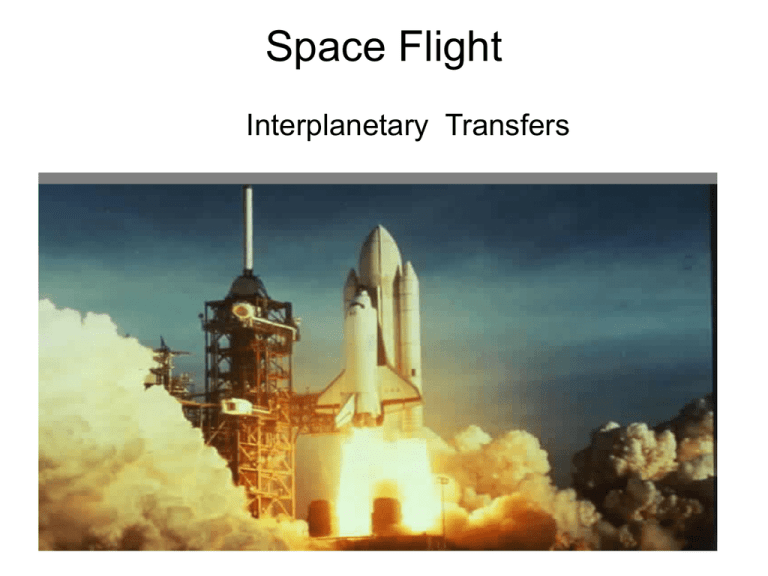
Space Flight Interplanetary Transfers History Pioneers • Konstantin Tsiokovsky • Robert Goddard • Hermann Oberth Overview • Space Flight • Trajectories with Chemical Rockets • Interplanetary Superhighway • Hoffman Transfers • Gravitational ‘Slingshot’ • Space Vehicles of future • Conclusions Thrust • Thrust is a reaction force described quantitatively by Newton's Second Law when a system expels or accelerates mass in one direction to propel a vehicle in the opposite direction • d(mv)/dt = v(dm/dt) + m(dv/dt) Delta-V • Delta-v is a measure used in astrodynamics to describe the amount of "effort" needed to carry out an orbital maneuver ; to change from one orbit to another Gravitational Sphere of influence • Laplace derived the following for the Radius of the Sphere of Influence • rP = DSP [MP/MSun]2/5 Where • DSP = the distance between the Sun and the Planet • MP = mass of the planet • MSun= mass of the Sun Example: Jupiter and Earth • Jupiter: MSun/MJ = 1047 DSP =5.02 AU rJ = 48.3 million km = 657 RJupiter • Earth: MSun/Mearth = 333,000 DSP = 1 AU re = 927,000 km = 2.4 x distance from Earth to the Moon = 145 Rearth • What is the most important thing for a Space Travel Project • For a SSTO, fuel and fuel tank constitutes 88% of the total launch weight and 67% for a single stage rocket • Lowering the delta-v requirements is one of the most important considerations as it implies less thrust is needed which in turn means less fuel and more payload Least energy transfers • Launch site and direction of launch • Interplanetary Superhighway • Hoffman Energy Transfers • Gravitational Slingshot Launch site • Launch from near equator Sitting on the launch pad near the equator, a rocket is already moving at a speed of over 0.4 km per second relative to Earth's center. Direction of Launch • Outward Bound : Launch in the direction of Earth’s rotation around its own axis (towards east) and launch towards the rotation around the sun (average velocity of approximately 29 km/sec along its orbital path) http://www2.jpl.nasa.gov/basics/bsf14-1.html Inward Bound : Do the opposite Interplanetary Superhighways • Lowest Delta-V requirements • based around a series of orbital paths leading to and from the unstable orbits around the Lagrange points Hohmann Transfer • First proposed in 1925 by German scientist Walter Hohmann • Most useful for launch to Mars and Venus • Space craft are launched to have an elliptical orbit . • The space craft covers less than 180 degrees in its orbit around the sun before reaching its target( Type I trajectory) • For superior planets perihelion is at earth and aphelion is at the planet. Energy increased at perihelion to increase aphelion distance • For inferior planets aphelion is at earth and perihelion is at the planet. Energy decreased at aphelion to decrease perihelion distance Travel to Mars The spacecraft is already in solar orbit as it sits on the launch pad. This existing solar orbit must be adjusted to cause it to take the spacecraft to Mars: The desired orbit's perihelion (closest approach to the sun) will be at the distance of Earth's orbit, and the aphelion (farthest distance from the sun) will be at the distance of Mars' orbit • perihelion= Earth orbital radius = 1 AU • aphelion= Mars orbital radius = 1.524 AU • semimajor axis ‘a’ of probe orbit a = (perihelion+ aphelion)/2= 1.262 AU • Using Kepler's third law to determine the orbital period, P. P2 = a3 period = (1.262)3/2 = 1.418 years = 518 days • Since the probe takes half of a period to get to Mars, the time of flight is 259 days or 0.709 years. Launch Window • This means that the probe must be launched 259 days before Mars is at its position in its orbit where the probe will intercept Mars. Mars' orbital period is 1.88 years and it will move 136 degrees in its orbit during the probe's trip to Mars. • Therefore at the time of launch Mars must be (180-136)=44 degrees greater heliocentric longitude than the Earth Delta-V Using Kepler's second law calculate delta-v. • The relative velocities are inversely proportion to the respective distances from the sun. rperihelion*vperihelion = raphelion*vaphelion • vperihelion = vcircular[(1+e)/(1-e)]1/2 • vaphelion = vcircular[(1-e)/(1-e)]1/2 • The circular velocity is the average velocity in orbit = 2πa/P Circular velocity = 26.5 km/sec vperihelion = 32.7 km/s • The Earth is moving at 29.7 km/s in its orbit, the velocity of the probe must be increased by 3.0 km/s relative to the Earth. • This ignores the pull of the Earth's gravity and is true when the probe is outside the influence of Earth's gravity • Similarly the vaphelion is 30km/sec, so the probe has to be slowed by 2.7km/sec to make it orbit around Mars Gravitational Slingshot • First suggested by Italian born American Scientist Giuseppe 'Bepi' Colombo • The probe ‘steals’ some of the angular momentum from a planet to increase its own speed, this barely has any impact on the planets velocity. • If spacecraft passes behind the motion of the planet craft gains speed and loses speed if it passes in from. • Escape velocity from earth is about 11.2 km/sec • If we manage to hurl a spacecraft at this speed from the ground then it escapes from the earth’s orbit. • It will still be in an identical earth like orbit around the sun • Escape velocity from solar system at earth’s orbit is 43km/sec • To send it to an outer planet or even out of the solar system we need to give the spacecraft enough energy Assist from Jupiter • First the space probe is sent to Jupiter using a Hohmann transfer • The delta-v needed just out of earth’s (perihelion) sphere of influence is 10.15 km/sec(39.95-29.8) (heliocentric velocities) • The craft loses energy steadily as it tries to climb out of the potential well. • On arrival at Jupiter (aphelion) the speed of the aircraft is 9.36 km/sec • The craft enters Jupiter’s sphere of influence with a velocity greater than the escape velocity of Jupiter (has to) • It is attracted towards Jupiter and the aircraft gains speed as it approaches the planet Paradox • The craft enters Jupiter’s sphere of influence with a velocity greater than the escape velocity of Jupiter (has to) • It is attracted towards Jupiter and the aircraft gains speed as it approaches the planet • After the point of closest approach the craft has maximum velocity and it starts to lose velocity. • Effectively it leaves Jupiter’s sphere of influence at the same speed at which it enters. • So where did the gain in velocity come from ? • The important thing to notice here is we need to increase the velocity of the spacecraft in the heliocentric frame • Skipping some the vector math, consider conservation of linear momentum mΔv=MΔV • The v,V are in heliocentric frame of reference. So the gain in velocity of the spacecraft happens only if the planet itself is moving with respect to the sun. • ΔV is of the order of 10-25 • We could make the spacecraft fly repeatedly around the planets if we can find a perfect launch window and attain huge speeds. • But the faster the spacecraft flies the harder it is for any planet to influence it with its gravity. • If we ever found a star system consisting of multiple black holes orbiting each other, we might be able to apply this scheme to achieve relativistic speeds, by looping around from one to the other. I suppose in this situation the achievable speed limit would depend on how close a spaceship could pass without be being destroyed by tidal forces. Still, if the black holes were large enough, the tidal forces even at the event horizon would be tolerable. Also, stopping at our destination might be tricky. Some Examples • Messenger is expected to reach Mercury by 2011 • It will fly once past Earth, twice past Venus and three times past Mercury for gravity assists — and make 15 loops around the sun — before slowing enough to slip into orbit around Mercury Voyager 2 Cassini and Ulysses • http://www.esa.int/esaCP/SEMXLE0P4HD_index_0.html Limits on Chemical Rockets • Achieving higher speeds require more fuel, which means added weight , which in turn makes it hard to increase a rockets speed • Even for small robotic missions the theoretical limit for chemical rockets is .001c • Interstellar travel ruled out Future space Vehicles • Nuclear Propulsion • Project Orion • Project Daedalus • Project Prometheus • Matter-Antimatter Engines • Solar Sails and beamed energy propulsion • Interstellar Ramjets Nuclear Propulsion • Project Orion • Lasted from 1958 to 1965 • Envisaged exploding nuclear bombs a few tenths of meters behind the rocket • Vaporized debris would impact a pusher plate on the back of spacecraft • Could be build from existing technology but would violate international agreements banning nuclear explosions in space Project Daedalus • British conceived project • Relies on continuos stream of energy from on board controlled fusion reaction • Out of current technological limits • Can achieve 0.01c like project Orion Project Prometheus • Spacecraft called Jupiter Moons icy orbiter • Work on this is currently going on • Will use electric propulsion from a small fission reactor Matter-Antimatter Engines • Theoretically can provide the most power per unit weight of fuel • Can reach 90% speed of light • To create 1 kg of anitmatter today requires more than annual fuel requirements of the world • Problem of containing antimatter • Out of current technology limits Sails and Beamed Energy • Already tried • Will have large, lightweight sails to be powered by radiation pressure from sun for small but continuous acceleration • After sun’s radiation becomes weak, powerful lasers can be shone at the sails • Not possible to build such a laser today • There is a problem of trying to stop . Sails and Beamed Energy Interstellar Ramjets • Collects interstellar hydrogen for fuel with a giant scoop. • Can reach very close to speed of light because it can accelerate continuosly • Slowing down will not be a problem • Still needs controlled fusion reaction and hence out of bounds of current technology Interstellar Ramjets References • Books • • • • Elements of Space Technology-Rudolf Meyer Rockets into space-Frank Winter The Cosmic Perspective- Jeffrey Bennett, Megan Donahue, Nicholas Donahue, Mark Voit Classical Dynamics-Marion and Thornton • Websites • http://encyclopedia.thefreedictionary.com/Gravitational%20sli ngshot • http://www.mathpages.com/home/kmath114.htm • http://www.go.ednet.ns.ca/~larry/orbits/gravasst/gravasst.htm l • http://saturn.jpl.nasa.gov/mission/gravity-assist-primer.cfm • http://en.wikipedia.org/wiki/Gravitational_slingshot • http://www.esa.int/esaCP/SEMXLE0P4HD_index_0.html

